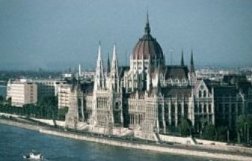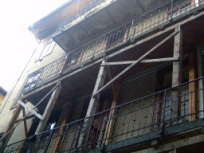Pechvogel - Geluksvogel 9.5.06 [NL]
Het leven van een Europese urban professional speelt zich voor een groot deel NIET af in een stedelijke omgeving. Tussen de te bezoeken steden ligt namelijk het platteland. Daar moet je doorheen, of je wilt of niet. In mijn geval is dat vaak per automobiel en via de snelweg. Het automobiel is een vaalgroene Renault Espace, bouwjaar 1993. En de snelwegen zijn eigenlijk nauwelijks platteland. Je begeeft je uren - of zelfs: dagen - lang in een sterk gefragmenteerde community, een multiculturele functionele gemeenschap, bestaande uit vrachtautochauffeurs, gezinsgewijs toerende toeristen,
handelsreizigers en het uitstervende volkje van lifters. Territoriaal dicht op elkaar gepakt: gebiedsconflicten en botsingen van allerlei aard zijn aan de orde van de dag. Functioneel zijn we ook verenigd: we willen allemaal dezelfde kant op. Onze club- en buurthuizen bestaan uit benzinestations en, vaak bijbehorende-, wegrestaurants, soms ook wegwerphotels in de vorm van ladenkasten. We haten die plekken, maar we doen niet veel moeite om ze te mijden.
De community wordt geregeerd en gecontroleerd door de verkeerspolitie, uiteraard. De functie van het buurtbeheer en de sociaal-culturele animatie valt toe aan het personeel van de wegrestaurants, de cassières van de benzinepompen en van de tolinzamelingsloketten. Maar er is één functie, die, vind ik, het meest lijkt op die van onze urban profs: de Wegenwacht. De ADAC, Touring Secours en, in Nederland: de ANWB. Al heb ik begrepen, dat ook in deze functies de privatisering en de marktwerking hebben toegeslagen, zodat er nu concurrerende wegenwachten zijn. Zogenaamd terwille van onze keuzevrijheid. Maar, juist als we ziek worden, een ongeluk krijgen of met pech langs de weg staan, hèbben we weinig keuze. Het schrikbeeld van het ziekenhuis dat ons wegstuurt omdat we niet de juiste polis hebben, de takelwagen die ons niet helpt, omdat hij voor een andere verzekeringsmaatschappij rijdt en de pechdienst, die ons een extra duur en overtollig spoed-lidmaatschap opdringt, dat schrikbeeld dreigt harde werkelijkheid te worden. Dwangconsumptie, koppelverkoop, ondershandse overeenkomsten tussen verzekeraars en dienstverleners: evenzovele BEPERKINGEN van onze keuzevrijheid.
Maar goed, we hadden het eigenlijk over wat anders. Over pech. Pech onderweg. Ik onderhoud m'n auto redelijk. Het is voor mij een belangrijk werk-tuig. In de stad, in de steden, is-i niet zo nodig. Hoewel - in een auto-stad als Brussel kan men eigenlijk niet zonder - zelfs om boodschappen te doen. Van de berijders van oude autos wordt echter verwacht, dat ze heel wat handiger en technischer zijn, dan ik. Zodoende, is pech mijn opdringerige metgezel, onderweg. Lekkende leidingen, stukknallende drijfriemen, sloten die niet sluiten, of juist niet willen opengaan, overkokend koelwater, slaphangende ruitenwissers in een hoosbui - een kleine bloemlezing.

Het verschil tussen een ramp en gewoon pech, heeft weinig te maken met de aard van het gebeuren. Dat heeft te maken met iets heel anders, namelijk de mogelijkheid, om een doelgerichte interventie, zo snel en zo efficiënt mogelijk te laten plaatsvinden. In het laatste geval is het gewoon, pech, vertraging, ongemak. Als ik goed georganiseerd ben, mijn mogelijkheden en beperkingen ken, kan ik een leerzaam leven leiden als pechvogel. Leerzaam, omdat het me in contact brengt met dienstverleners onder een motorhelm (zie foto), die er zijn, om een probleem OP TE LOSSEN, en niet om zo veel mogelijk geld te verdienen aan je. Dat zijn de urban professionals-van-de-weg. Ze werken, niet in functie van een "prestatiecontract", maar zoals ouderwetse artsen, notarissen of vroedvrouwen: het resultaat telt, niet de vraag of men zich aan een bepaald programma houdt. Dus: eigenlijk net zoals projectleiders, buurtbeheerders in een achterstandswijk.
Zo wordt pech bijna een plezier. Het opent nieuwe perspectieven. Het geeft energie.
Mensen met naar verhouding veel pech in het leven, zijn alleen vooruit te helpen met mensen zoals wij.

 [EN]
[EN] [FR]
[FR] [DE]
[DE]


 Huib
Huib





I walked out with a much better picture of what might have happened. Looking at the inside of real flight decks, real air traffic control centers, looking at real people doing the same things to start that morning they did every other morning is illuminating, quietly and effectively. Good use of the tools of film-making.